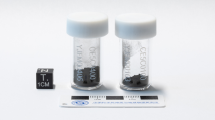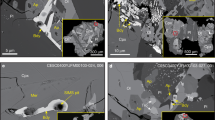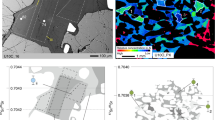Abstract
The origin and evolution of the Moon remain controversial1,2, with one of the most important questions for lunar evolution being the timing and duration of basaltic (mare) magmatism1,3,4,5,6,7,8. Here we report the result of ion microprobe U–Pb dating of phosphates in a lunar meteorite, Kalahari 009, which is classified as a very-low-Ti mare-basalt breccia. In situ analyses of five phosphate grains, associated with basaltic clasts, give an age of 4.35 ± 0.15 billion years. These ancient phosphate ages are thought to represent the crystallization ages of parental basalt magma, making Kalahari 009 one of the oldest known mare basalts. We suggest that mare basalt volcanism on the Moon started as early as 4.35 Gyr ago, relatively soon after its formation and differentiation, and preceding the bulk of lunar volcanism which ensued after the late heavy bombardment around 3.8-3.9 Gyr (refs 7 and 8). Considering the extremely low abundances of incompatible elements such as thorium and the rare earth elements in Kalahari 009 (ref. 9) and recent remote-sensing observations illustrating that the cryptomaria tend to be of very-low-Ti basalt type10,11,12, we conclude that Kalahari 009 is our first sample of a very-low-Ti cryptomare from the Moon.
This is a preview of subscription content, access via your institution
Access options
Subscribe to this journal
Receive 51 print issues and online access
$199.00 per year
only $3.90 per issue
Buy this article
- Purchase on Springer Link
- Instant access to full article PDF
Prices may be subject to local taxes which are calculated during checkout


Similar content being viewed by others
References
Schultz, P. H. & Spudis, P. D. Beginning and end of lunar mare volcanism. Nature 302, 233–236 (1983)
Yin, Q. et al. A short timescale for terrestrial planet formation from Hf–W chronometry of meteorites. Nature 418, 949–951 (2002)
Wieczorek, M. A. & Phillips, R. J. The “Procellarum KREEP Terrane”: Implications for mare volcanism and lunar evolution. J. Geophys. Res. 105, 20417–20430 (2000)
Hess, P. C. & Parmentier, E. M. A model for the thermal and chemical evolution of the Moon's interior: Implications for the onset of mare volcanism. Earth Planet. Sci. Lett. 134, 501–514 (1995)
Elkins-Tanton, L. T., Hager, B. H. & Grove, T. L. Magmatic effects of the lunar late heavy bombardment. Earth Planet. Sci. Lett. 222, 17–27 (2004)
Nyquist, L. E., Bogard, D. D. & Shih, C.-Y. The Century of Space Science 1325–1376 (eds Bleeker, J. A. M., Geiss, J. & Huber, M. C. E.) (Kluwer Academic, Dordrecht, 2001)
Stöffler, D. & Ryder, G. Stratigraphy and isotope ages of lunar geologic units: chronological standard for the inner solar system. Space Sci. Rev. 96, 9–54 (2001)
Hiesinger, H., Head, J. W., Wolf, U., Jaumann, R. & Neukum, G. Ages and stratigraphy of mare basalts in Oceanus Procellarum, Mare Nubium, Mare Cognitum, and Mare Insularum. J. Geophys. Res. 108 (1). 1–27 (2003)
Schulz, T. et al. Chemical composition and Lu/Hf-age of the Lunar mare basalt meteorite Kalahari 009. Meteorit. Planet. Sci. 42, A137 (2007)
Giguere, T. A. et al. Remote sensing studies of the Lomonosov-Fleming region of the Moon. J. Geophys. Res. 108 (4). 1–14 (2003)
Hawke, B. R. et al. Remote sensing and geologic studies of the Balmer-Kapteyn region of the Moon. J. Geophys. Res. 110 E06004 doi: 10.1029/2004JE002383 (2005)
Hawke, B. R. et al. The earliest mare basalts. Lunar Planet. Sci. Conf. 36, abstr. 1642. (2005)
Taylor, L. A. et al. Pre-4.2 AE mare-basalt volcanism in the lunar highlands. Earth Planet. Sci. Lett. 66, 33–47 (1983)
Dasch, E. J., Shih, C.-Y., Bansal, B. M., Wiesmann, H. & Nyquist, L. E. Isotopic analysis of basaltic fragments from lunar breccia 14321—chronology and petrogenesis of pre-Imbrium mare volcanism. Geochim. Cosmochim. Acta 51, 3241–3254 (1987)
Terada, K. et al. Uranium-lead systematics of phosphates in lunar basaltic regolith breccia, Meteorite Hills 01210. Earth Planet. Sci. Lett. 259, 77–84 (2007)
Anand, M. et al. Petrology and geochemistry of LaPaz icefield 02205: a new unique low-Ti mare-basalt meteorite. Geochim. Cosmochim. Acta 70, 246–264 (2006)
Anand, M. et al. Petrogenesis of lunar meteorite EET 96008. Geochim. Cosmochim. Acta 67, 3499–3518 (2003)
Leich, D. A., Kahl, S. B., Kirschbaum, A. R., Niemeyer, S. & Phinney, D. Rare gas constraints on the history of Boulder 1, Station 2, Apollo 17. The Moon 14, 407–444 (1975)
Head, J. W. & Wilson, L. Lunar mare volcanism: Stratigraphy, eruption conditions, and the evolution of secondary crusts. Geochim. Cosmochim. Acta 56, 2155–2175 (1992)
Sokol, A. K. & Bischoff, A. Meteorites from Botswana. Meteorit. Planet. Sci. A 40, 177–184 (2005)
Fernandes, V. A., Burgess, R., Bischoff, A., Sokol, A. K. & Haloda, J. Kalahari 009 and north east Africa 003: young (<2.5 Ga) lunar mare basalt. Lunar Planet. Sci. Conf. 38, abstr. 1611. (2007)
Gillis, J. J., Jolliff, B. L. & Korotev, R. L. Lunar surface geochemistry: Global concentrations of Th, K, and FeO. Geochim. Cosmochim. Acta 68, 3791–3805 (2004)
Schultz, P. H. & Spudis, P. D. Evidence for ancient mare volcanism. Proc. Lunar Planet. Sci. Conf. 10, 2899–2918 (1979)
Hawke, B. R. & Bell, J. F. Remote sensing studies of lunar dark-halo impact craters: Preliminary results and implications for early volcanism. Proc. Lunar Planet. Sci. Conf. 12, 665–678 (1981)
Antonenko, I. Global estimates of cryptomare deposits: implications for lunar volcanism. Lunar Planet. Sci. Conf. 30, abstr. 1703. (1999)
Snyder, G. A. et al. in Origin of the Earth and Moon (eds Canup, R. M. & Righter, K.) 361–395 (Univ. Arizona Press, Tucson, 2000)
Papike, J. J. et al. Evolution of the lunar crust: SIMS study of plagioclase from ferroan anorthosites. Geochim. Cosmochim. Acta 61, 2343–2350 (1997)
Dickinson, T. et al. Apollo 14 aluminous mare basalts and their possible relationship to KREEP. Proc. Lunar Planet. Sci. Conf. 15 (2). C365–C374 (1985)
Shearer, C. K. et al. Thermal and magmatic evolution of the moon. Rev. Mineral. Geochem. 60, 365–518 (2006)
Sano, Y., Oyama, T., Terada, K. & Hidaka, H. Ion microprobe U-Pb dating of apatite. Chem. Geol. 153, 249–258 (1999)
Ludwig, K. R. Users Manual for Isoplot/Ex: a Geochronological Toolkit for Microsoft Excel (Berkeley Geochronology Center, Special Publication 1a, 2001)
Acknowledgements
We thank K. R. Ludwig for providing the Isoplot/Ex program for U–Pb age calibration. We thank A. G. Tindle and J. Berndt-Gerdes for assistance with microprobe work. We thank L. E. Thomas and R. A. Spicer for proof-reading the manuscript for English usage. We also thank L. E. Nyquist and J. Head for their constructive comments. This contribution is an outcome of a joint project between the Hiroshima University and the Open University. This study is partly supported by a Scientific Research Grant of the Ministry of Education, Culture, Sports, Science and Technology, the Itoh Science foundation and the German Research Foundation. M.A. acknowledges support of PPARC and RCUK fellowships.
Author Contributions K.T. and M.A. contributed equally to this work.
Author information
Authors and Affiliations
Corresponding authors
Rights and permissions
About this article
Cite this article
Terada, K., Anand, M., Sokol, A. et al. Cryptomare magmatism 4.35 Gyr ago recorded in lunar meteorite Kalahari 009. Nature 450, 849–852 (2007). https://doi.org/10.1038/nature06356
Received:
Accepted:
Issue Date:
DOI: https://doi.org/10.1038/nature06356
This article is cited by
-
A lunar time scale from the perspective of the Moon’s dynamic evolution
Science China Earth Sciences (2024)
-
Volcanism in the Solar System
Science China Earth Sciences (2023)
-
A model of crust–mantle differentiation for the early Earth
Acta Geochimica (2022)
-
A comparison of inner Solar System volcanism
Nature Astronomy (2019)
Comments
By submitting a comment you agree to abide by our Terms and Community Guidelines. If you find something abusive or that does not comply with our terms or guidelines please flag it as inappropriate.



